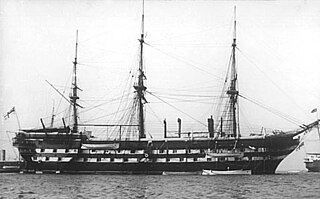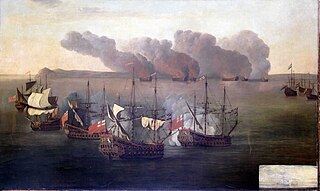
HMS Royal Oak was a 74-gun third-rate ship of the line of the Royal Navy, built by Jonas Shish at Deptford and launched in 1674. She was one of only three Royal Navy ships to be equipped with the Rupertinoe naval gun. Life aboard her when cruising in the Mediterranean Sea in 1679 is described in the diary of Henry Teonge.

HMS Boscawan was a 70-gun third rate ship of the line of the Royal Navy, launched on 3 April 1844 at Woolwich Dockyard. She was originally ordered in 1812 and begun as a 74-gun Vengeur-class ship of the line, but the order was cancelled and her frames placed instorage; an Admiralty order dated 3 March 1834 required that those frames be reworked to Sir William Symonds' design. She was named for Admiral Edward Boscawen.

HMS Britannia was a 120-gun first-rate ship-of-the-line of the Royal Navy, laid down in 1813 and launched on 20 October 1820.
HMS Greenwich was a 54-gun fourth-rate ship of the line of the Royal Navy, built by Christopher Pett at Woolwich Dockyard and launched in 1666.

HMS Falkland was a 50-gun fourth-rate ship of the line of the Royal Navy, built by Holland of New Castle, New Hampshire, and purchased by the navy in 1696.

HMS St Michael was a 90-gun second rate ship of the line of the Royal Navy, built by John Tippetts of Portsmouth Dockyard and launched in 1669.

HMS Oxford was a 54-gun fourth-rate ship of the line of the Royal Navy, built by Francis Baylie in Bristol and launched in June 1674. Her guns comprised twenty-two 24-pounders on the lower deck, with twenty-two large sakers (8-pounders) on the upper deck and ten smaller sakers (5-pounders) on the quarterdeck.
Lyme was a 52-gun third rate Speaker-class frigate built for the navy of the Commonwealth of England at Portsmouth, and launched in 1654.
Sapphire was a 38-gun fourth-rate of the Commonwealth of England. After commissioning she was actively involved in the First Anglo-Dutch War, participating in most major fleet actions. During the Second Anglo-Dutch War, she was only in the first two engagements then spent her time in Irish Waters and the Mediterranean. She was run ashore due to a pending attack by suspected Algerian pirates on Sicily in March 1670.

President was a 38-gun fourth rate frigate of the Royal Navy, originally built for the navy of the Commonwealth of England by Peter Pett I at Deptford Dockyard, and launched in 1650.
The Pelican was one of six 40-gun fourth-rate frigates, built for the Commonwealth of England under the 1650 Programme. After commissioning she partook in the First Anglo-Dutch War being present at the Battles of Kentish Knock, Portland, the Gabbard and Scheveningen. She was accidentally burnt at Portsmouth in early 1656.

HMS Centurion was one of six 40-gun fourth-rate frigates, built for the Commonwealth of England under the 1650 Programme, she would be transferred to the navy of the Kingdom of England upon the Restoration of the monarchy in May 1660. When commissioned she partook in the First Anglo-Dutch War. After the first war ended she was in the Mediterranean fighting the Algerines at the Battle of Santa Cruz. She fought the battles of Dover, Portland, the Gabbard, and Scheveningen. During the Second Anglo-Dutch War she partook in the battles of Lowestoft and Orfordness. Following the second war she spent her time either in North America or the Mediterranean. She was wrecked in a storm in December 1689.
HMS Assistance was one of six 40-gun fourth-rate frigates, built for the Commonwealth of England under the 1650 Programme, after the Restoration of the monarchy in 1660 she was incorporated into the navy of the Kingdom of England. During her time in the Commonwealth Navy she partook in the First Anglo-Dutch War being present in the battles of Kentish Knock, Portland and The Gabbard. In the Mediterranean she was present at the Battle of Santa Cruz and the bombardment of Porto Farina, In the Second Anglo-Dutch War she was involved in the Battle of Lowestoft, Battle of Vagen and the St James Day Fight. She did not participate in fleet actions after this. She spent the rest of her service life undergoing several rebuilds and plying the waters as a cruiser protecting British trade and projecting British sovereignty. After nearly 95 years of Service she was sunk as a break water at Sheerness at the end of 1745.
Laurel was a 48-gun fourth-rate of the navy of the Commonwealth of England. She participated in almost all major Fleet Actions of the First Anglo-Dutch War. She was an active participant in the battles of Kentish Knock, Dungeness, Portland, The Gabbard and Scheveningen. She went to the west Indies with Admiral William Penn. She was wrecked in May 1657.
Diamond was a 40-gun fourth-rate frigate of the English Royal Navy, originally built for the navy of the Commonwealth of England by Peter Pett at Deptford Dockyard, and launched on 15 March 1652. By 1677 her armament had been increased to 48 guns.

HMS Boyne was an 80-gun third-rate ship of the line of the Royal Navy, launched at Deptford Dockyard on 21 May 1692.

HMS Portland was a 50-gun fourth rate ship of the line of the Royal Navy, launched at Woolwich Dockyard on 28 March 1693. One of two 50-gun ships ordered on 17 February 1692.
HMS Rochester was a 50-gun fourth rate ship of the line of the Royal Navy, and the fifth such ship to be ordered in 1692. She was launched at Chatham Dockyard on 15 March 1693.

HMS Cumberland was a three-deck 80-gun third rate ship of the line of the Royal Navy, built by Joseph Allin the elder at Deptford Dockyard and launched on 27 December 1710. Her design corresponded to that laid down by the 1706 Establishment of dimensions for 80-gun ships.

HMS Portland was a 50-gun fourth rate ship of the line of the Royal Navy, built at Limehouse according to the dimensions laid down in the 1741 proposals of the 1719 Establishment, and launched on 11 October 1744.












